Last night, I was a guest with Lou Dobbs to discuss Washington v. Trump. When asked about the rogue 9th Circuit, I referenced the probably-apocryphal Stephen Reinhardt quote: “They can’t catch ’em all.” Dobbs cracked up laughing.
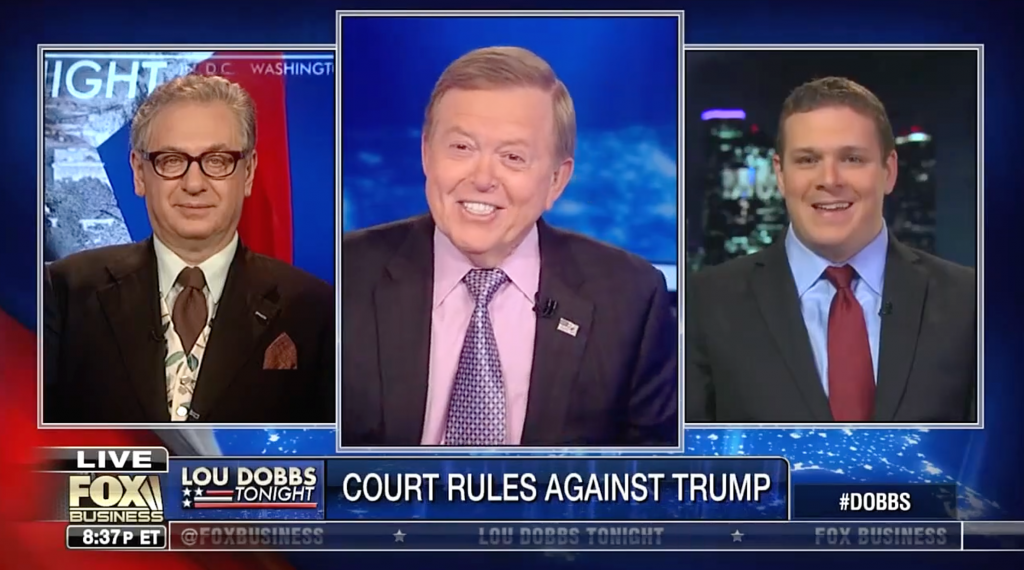
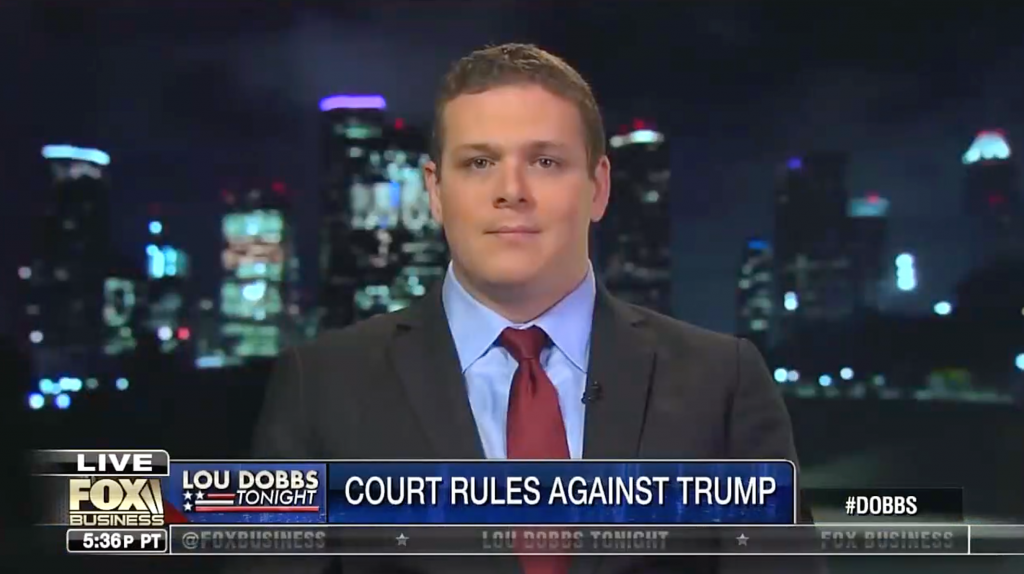
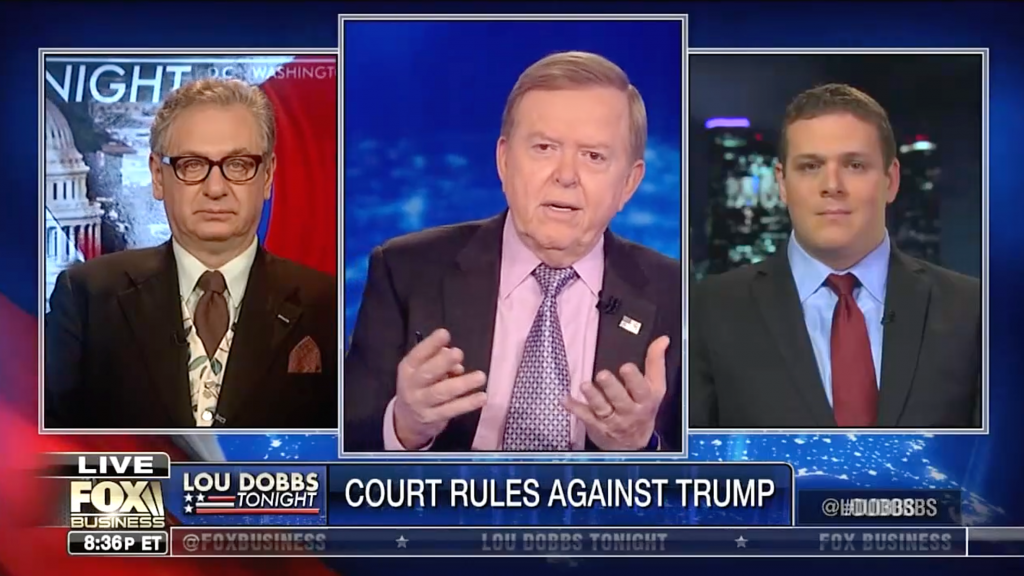
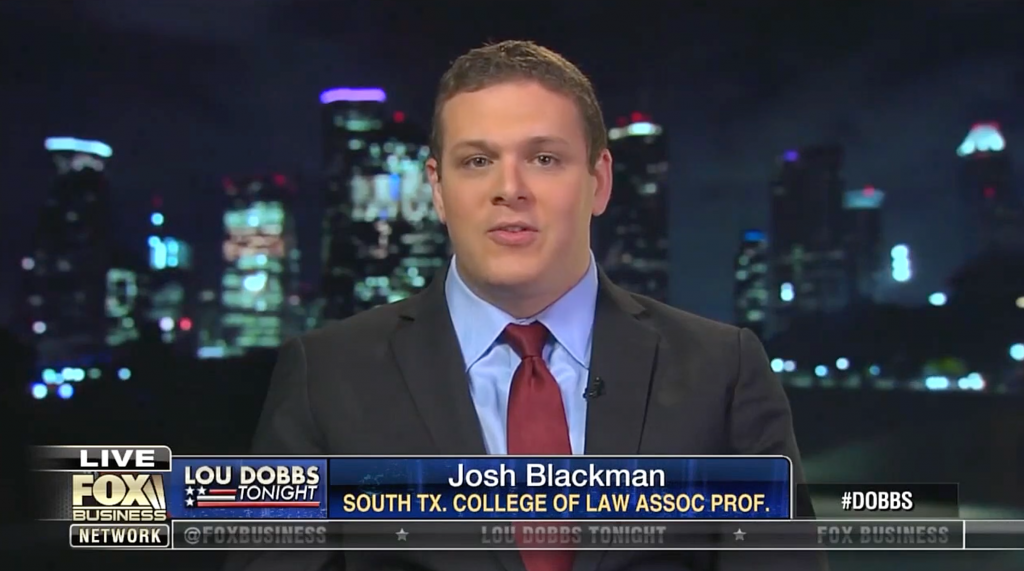

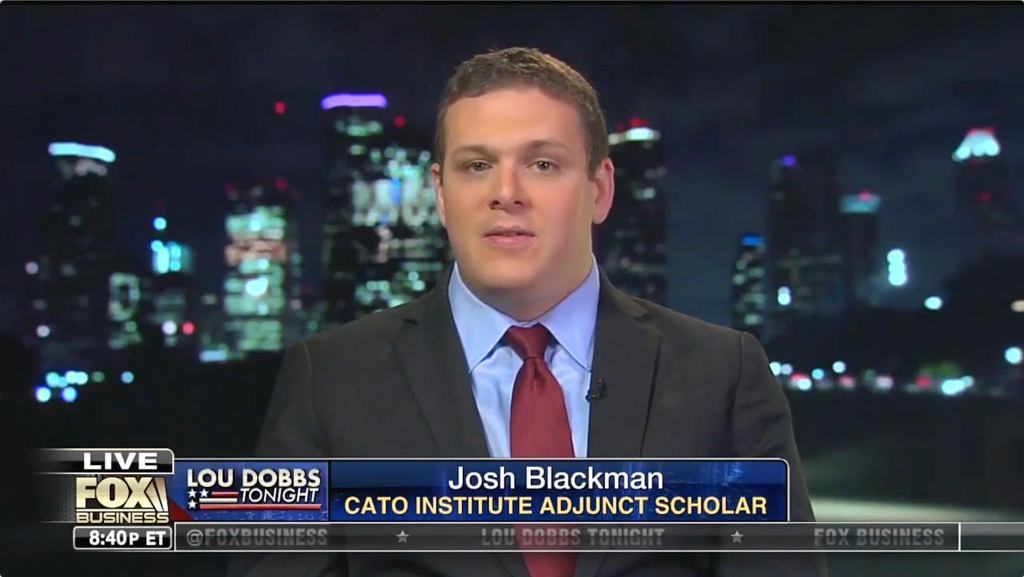
Last night, I was a guest with Lou Dobbs to discuss Washington v. Trump. When asked about the rogue 9th Circuit, I referenced the probably-apocryphal Stephen Reinhardt quote: “They can’t catch ’em all.” Dobbs cracked up laughing.






This morning, my worlds collided as Donald Trump tweeted (without any context) a sentence from Ben Wittes’s post on Washington v. Trump.
LAWFARE: “Remarkably, in the entire opinion, the panel did not bother even to cite this (the) statute.” A disgraceful decision!
— Donald J. Trump (@realDonaldTrump) February 10, 2017
Once again, Trump has stumbled into an important jurisprudential point. The fact that the President is exercising powers given to him from Congress, augmented by his own inherent authorities, indicates we are in Justice Jackson’s first tier from Youngstown, where judicial scrutiny is at its minimum.
8 U.S.C. § 1182(f) allows the President to deny “entry” to “classes of aliens” he deems “detrimental to the interests of the United States.” (For a discussion of this provision, see Part II of my series).
Whenever the President finds that the entry of any aliens or of any class of aliens into the United States would be detrimental to the interests of the United States, he may by proclamation, and for such period as he shall deem necessary, suspend the entry of all aliens or any class of aliens as immigrants or nonimmigrants, or impose on the entry of aliens any restrictions he may deem to be appropriate.
During his remarks on Wednesday, President Trump–in his own crude fashion–engaged in statutory interpretation and offered an articulation of Justice Jackson’s framework (with a fascinating detour on gender pronouns in statutes):
But I’m going to read what’s in dispute, what’s in question. And you will see this — it’s INA 212(f) 8 U.S.C. 1182(f): “Suspension of entry or imposition of restrictions by the President” — okay, now, this isn’t just me, this is for Obama, for Ronald Reagan, for the President. And this was done, very importantly, for security — something you people know more about than all of us. It was done for the security of our nation, the security of our citizens, so that people come in who aren’t going to do us harm.
And that’s why it was done. And it couldn’t have been written any more precisely. It’s not like, oh, gee, we wish it were written better. It was written beautifully. So just listen, here’s what it says. This is what they’re arguing:
“Whenever the President finds that the entry of any aliens” — okay, the entry, the entry of any aliens — “or of any class of aliens” — so any aliens, any class of aliens — “into the United States” — so the entry of people into the United States. Let’s say, just to be precise, of aliens into the United States.
So any time — “whenever the President finds that the entry of any alien or any class of aliens into the United States would be detrimental to the interests of the United States” — right? So if I find, as President, that a person or group of people will be detrimental to the interests of the United States — and certainly there’s lots of examples that we have, but you shouldn’t even have them, necessarily — he may be — and “he may by proclamation, and for such period as he shall deem necessary…” Now, the only mistake is they should have said “he or she.” But hopefully, it won’t be a she for at least another seven years. After that, I’m all — (laughter and applause.) See? I just noticed that, actually. I just noticed it. I’m saying, whoa, this is not politically correct. It’s correct, but it’s not politically correct, you know, this is the old days.
He may by proclamation and for such period as he shall deem necessary — so here it is, people coming in — suspend the entry of all aliens. Right? That’s what it says. It’s not like — again, a bad high school student would understand this. Anybody would understand this. Suspend the entry of all aliens or any class of aliens as immigrants or non-immigrants, or impose on the entry of aliens. Okay, so you can suspend the aliens, right? You can suspend the aliens from coming in — very strong — or impose on the entry of aliens any restrictions he may deem to be appropriate.
Okay. So you can suspend, you can put restrictions, you can do whatever you want. And this is for the security of the country — which, again, you’re the chiefs, you’re the sheriffs. You understand this.
We are not in a Zone of Twilight here. Not even close. As a matter of inherent Article II authority, even in the absence of any statute, the President could deny entry to the United States of those he deems dangerous. But that is not the entire calculus. Here Congress has, with unequivocal language, delegated its Article I powers over immigration to the President. In Justice Jackson’s words:
When the President acts pursuant to an express or implied authorization of Congress, his authority is at its maximum, for it includes all that he possesses in his own right plus all that Congress can delegate.[2] In these circumstances, and in these only, may he be said (for what it may be worth) to personify the federal sovereignty. If his act is held unconstitutional under these circumstances, it usually means that the Federal Government as an undivided whole lacks power. A seizure executed by the President pursuant to an Act of Congress would be supported by the strongest of presumptions and the widest latitude of judicial interpretation, and the burden of persuasion would rest heavily upon any who might attack it.
The 9th Circuit did not apply a presumption of constitutionality. Nor did it impose a wide latitude of interpretation. Rather, without any precedent, it imposed an insurmountable burden on the government. Had the panel even bothered to engage with the statute, it would have realized we are in Jackson’s first zone, and that judicial scrutiny must be at an absolutely minimum. The court should have presumed that when Congress afforded the President this power, it did not think Due Process controlled, for it failed to put in any review mechanisms (in contrast to countless other provisions of the immigration laws). There is every indication that, at least with respect to denial of entry, Congress agreed the President had plenary power.
Instead, the court applied something approaching strict scrutiny to the denial of entry for certain aliens who have zero connection to the United States. Really, it applied the sort of scrutiny Justice Jackson wrote about in the third tier:
Presidential claim to a power at once so conclusive and preclusive must be scrutinized with caution, for what is at stake is the equilibrium established by our constitutional system.
There are so many grounds to criticize the panel’s decision, but the failure to even discuss the statutory framework is inexcusable because it allowed the judges to look away from Justice Jackson.
Last night I opined on the substantive merits of the 9th Circuit’s opinion in Washington v. Trump, as well as the stunning standard of review it applied–whether “any alien from one of the countries named in the Order has perpetrated a terrorist attack in the United States.” In this post, I’d like to study the procedural aspects of the panel’s decision, and explain what this posture means for the case going forward.
Washington argued that an appeal of a temporary restraining order is not appropriate. As a general matter, that is correct. Parties can seek mandamus of a temporary restraining order, but that form of review is far more narrow. However, the government urged the 9th Circuit to treat Judge Robart’s decision (2 paragraphs with no analysis) as if it were a preliminary injunction. That move entailed an important risk. If the 9th Circuit agreed that Judge Robart’s decision could be treated as a preliminary injunction, then the panel could exercise broader review; but on the flipside, if in fact it was a preliminary injunction, there were be no further opportunity to actually hold a preliminary injunction hearing and submit evidence to the record.
The Ninth Circuit indeed ruled that Judge Robart’s decision should be treated as a preliminary injunction, and thus it could exercise appellate jurisdiction.
We are satisfied that in the extraordinary circumstances of this case, the district court’s order possesses the qualities of an appealable preliminary injunction. The parties vigorously contested the legal basis for the TRO in written briefs and oral arguments before the district court. The district court’s order has no expiration date, and no hearing has been scheduled. Although the district court has recently scheduled briefing on the States’ motion for a preliminary injunction, it is apparent from the district court’s scheduling order that the TRO will remain in effect for longer than fourteen days. In light of the unusual circumstances of this case, in which the Government has argued that emergency relief is necessary to support its efforts to prevent terrorism, we believe that this period is long enough that the TRO should be considered to have the qualities of a reviewable preliminary injunction.
There is an important shortcoming in this analysis: DOJ filed a brief on the eve of the oral argument, and (as far as I can tell) did not submit any evidence to the record. Nor was there any sort of evidentiary hearing, where the government could submit information (perhaps even classified) to rebut Washington’s case. And, as far as I can tell, there will not be such a hearing. Contemporaneously with the release of the per curiam opinion, the panel released an unpublished procedural order. It sets out this briefing schedule:
Any motion for reconsideration or reconsideration en banc of the court’s February 9, 2017 order denying the motion for stay is due within 14 days. See 9th Cir. R. 27-10(a)(2). If a motion for reconsideration or reconsideration en banc is filed, a response to the motion shall be filed within 7 days after service of the motion. See 9th Cir. R. 27-10(b).
The following briefing schedule shall govern this appeal: the opening brief is due March 3, 2017; the answering brief is due March 24, 2017; and the optional reply brief is due March 29, 2017.
According to this order, the panel does not envision this case going back to Judge Robart at all. To this effect, late last night Washington submitted a letter to Judge Robart, noting that unless it hears otherwise, the state will treat the prior-issued scheduling order as moot. It states:
This afternoon, the Ninth Circuit denied an emergency motion for a stay of the temporary injunction imposed by Judge Robart. The Court of Appeals held that the district court order “possesses the qualities of an appealable preliminary injunction” and established a briefing schedule for the appeal of the district court order. Washington v. Trump, Case No. 17-35105, slip op. at 8, Dkt. Entry 134 (9th Cir. 2017); id. at Dkt. Entry 135 (ECF Nos. 68, 69). In light of the Court of Appeals decision, the States assume the district court briefing schedule is no longer applicable. The States will not be filing a preliminary injunction motion and brief in the district court tonight, unless we receive contrary guidance from the district court.
This posture puts the Trump Administration in a lose-lose procedural posture. The court noted at several points that there is “no evidence” in the record to support the executive order.
Despite the district court’s and our own repeated invitations to explain the urgent need for the Executive Order to be placed immediately into effect, the Government submitted no evidence to rebut the States’ argument that the district court’s order merely returned the nation temporarily to the position it has occupied for many previous years.
But now, the federal government will not have any opportunity to actually submit any evidence into the record. In theory, at least, the Justice Department could include affidavits attached to its subsequent pleadings–perhaps under seal if it contains classified information. I’ve long railed against Circuit Courts finding facts on appeal. In this case, especially, where there is no opportunity for an evidentiary hearing, such a procedure is entirely inappropriate. But here we are.
So what are the possible paths going forward? I sketched out three options earlier this week, but here are my latest thoughts.
First, the government can file a petition for rehearing en banc. The likelihood that this gets granted is close to zero. But it may generate a dissent from denial–some reasoned opinion showing that circuit judges are not all in agreement. (At times like this, I am sad that Judge O’Scannlain has assumed senior status). The biggest virtue of this move is that it buys the government some time. During this pause, the government can figure what it wants to do with the Supreme Court. Alternatively, it withdraw the executive order and issue a new one its stead. More importantly, depending on how long this process takes, it is feasible for Justice Gorsuch to get on the bench by the time an appeal would be heard.
Second, the government can rush to the Supreme Court, and seek an emergency stay. This would entail filing an application for a stay with Circuit Justice Kennedy. However, I am doubtful there are five votes for this option. Also, a denial will be seen as a defeat, and a signal (on the shadow docket) that Trump is unlikely to succeed on the merits.
Third, the government can file a petition for certiorari before judgment. This only takes four votes to grant. If they go down the en banc road first, it might buy a few weeks, and by the time the case goes for argument, we may have nine Justices.
Fourth, the government can do nothing, and proceed to file merit briefs later in March before the three-judge panel. This is futile. I can’t imagine the panel changing its mind from the initial decision–especially, if the burden is to demonstrate that individuals from those seven countries have in fact engaged in an act of terrorism. We know the answer to that question is zero. So there is no likelihood of reversal in further proceedings.
Fifth, the government can withdraw the executive order, and issue a more narrowly tailored order. This would not necessarily moot the litigation, under the voluntary cessation doctrine, but it would eliminate any grounds for standing for green card holders and others with a connection to the United States. It would also place the focus on people with no connections to the United States, such as refugee applicants. (Apparently, the White House is planning a rewrite of the order). This is a much stronger litigation posture.
None of these options are good for the Trump Administration. My recommendation–not that anyone is listening–go through Door #5 and let the courts consider a final, more narrowly tailored order, rather than an interim, blunderbuss order.
At some point over the last week, I published my 10,000th blog post on JoshBlackman.com. I launched the blog on September 29, 2009. Over the course of seven years and four months, I’ve averaged about 113 blog posts per month, or a bit less than 4 a day. I wrote my 9,000th post in September 2015, 8,000th in August 2014, 7,500th in April 2014, 6,000th in July 2013, 5,000th in December 2012, 4,000th in April 2012, 3,500th in February 2012, 3,000th in November 2011, 2,000th in November 2011, and 1,500th in January 2011. As some readers may have discerned, over the past year I tried to deliberately slow down on blogging to focus more on longer-form pieces in National Review and elsewhere.
However, if the last three weeks are any indication, things are moving too quickly to wait for publications. My current strategy is to react to breaking news with lengthy twitter threads (sometimes 20 or 30 tweets deep), and then copy those tweets into a blog post. It’s not as elegant as the old instant analyses of days gone by, but it allows me to quickly reach many more people in a short time. Since the inauguration, my Twitter follower count has jumped from 6,500 to nearly 9,000. Readers who wish to get my quickest take can check the twitter feed in the right-hand column of this site, or (I would strongly encourage you to) join Twitter. You don’t need to tweet–only follow.
One of the most remarkable aspects of the oral arguments in Washington v. Trump, and the ensuing unanimous opinion, was the court’s demand that the government provide satisfactory evidence to justify the executive order. Generally, in the sphere of national security, the courts take the government’s representations on their face.(See my earlier post on second-guessing on national security). That was not the approach employed in Washington v. Trump. The panel imposed a “no evidence” standard on the government. Consider this discussion concerning the balance of hardships:
The Government has not shown that a stay is necessary to avoid irreparable injury. Nken, 556 U.S. at 434. Although we agree that “the Government’s interest in combating terrorism is an urgent objective of the highest order,” Holder v. Humanitarian Law Project, 561 U.S. 1, 28 (2010), the Government has done little more than reiterate that fact. Despite the district court’s and our own repeated invitations to explain the urgent need for the Executive Order to be placed immediately into effect, the Government submitted no evidence to rebut the States’ argument that the district court’s order merely returned the nation temporarily to the position it has occupied for many previous years.
Here, taking Washington’s assertions of fact in its complaint about national security as true, the court found that the government did not meet its burden to rebut that evidence.(In another area of schedfreude, I’ve argued for some time that courts should accept the facts as pleaded in a TRO). More to the point, Washington’s assertions were based on newspaper clippings, whereas the government had access to classified information. (The statement from numerous national security officials, who received briefings as recently as a month ago, could serve a different purpose).
The court repeats that there is no evidence that any aliens from these countries has “perpetrated a terrorist attack.” This is a much higher burden than whether any aliens were arrested, the question pose during oral arguments.
The Government has pointed to no evidence that any alien from any of the countries named in the Order has perpetrated a terrorist attack in the United States.7
Why is this the standard? Does the government really need to wait for an alien from one of these countries to kill Americans before such a ban is justified? I am totally unsympathetic to the ban, but this standard of review is bonkers.
Further, in a footnote, the government asserts that Congress’s decision to impose heightened visa restrictions does not justify a far greater ban on entry.
7 Although the Government points to the fact that Congress and the Executive identified the seven countries named in the Executive Order as countries of concern in 2015 and 2016, the Government has not offered any evidence or even an explanation of how the national security concerns that justified those designations, which triggered visa requirements, can be extrapolated to justify an urgent need for the Executive Order to be immediately reinstated.
This sentiment goes far behind saying there is “no evidence.” Now, the evidence provided–that is, supported by the President and Congress–is not adequate.
Finally, in another footnote, the court urges the Executive to submit classified information (through the Classified Information Procedures Act) for the court’s review.
Rather than present evidence to explain the need for the Executive Order, the Government has taken the position that we must not review its decision at all.8
In addition, the Government asserts that, “[u]nlike the President, courts do not have access to classified information about the threat posed by terrorist organizations operating in particular nations, the efforts of those organizations to infiltrate the United States, or gaps in the vetting process.” But the Government may provide a court with classified information. Courts regularly receive classified information under seal and maintain its confidentiality. Regulations and rules have long been in place for that. 28 C.F.R. § 17.17(c) (describing Department of Justice procedures to protect classified materials in civil cases); 28 C.F.R. §17.46(c) (“Members of Congress, Justices of the United States Supreme Court, and Judges of the United States Courts of Appeal and District Courts do not require a determination of their eligibility for access to classified information . . . .”); W.D. Wash. Civ. L.R. 5(g) (providing procedures governing filings under seal).
And what if that evidence is still not adequate? I fear the court is opening a door that it will promptly slam shut. The judges have already determined this ban is inadequate. Now, the government needs to provide dossiers to persuade the court that the policy is proper. It’s not enough to produce some evidence. They must produce satisfactory evidence. That is why the phrase “no evidence” is not entirely accurate. The court wants “adequate evidence.”